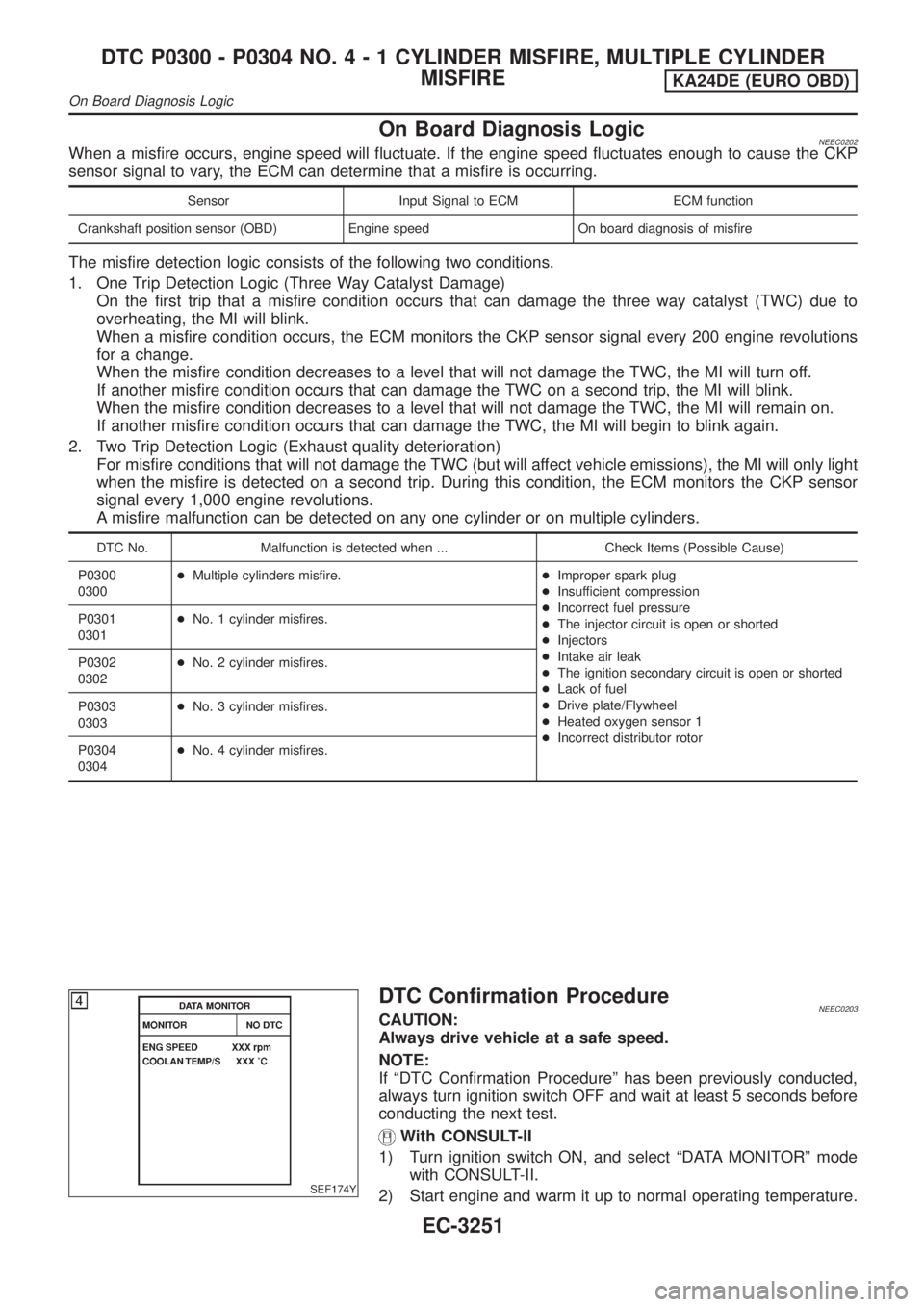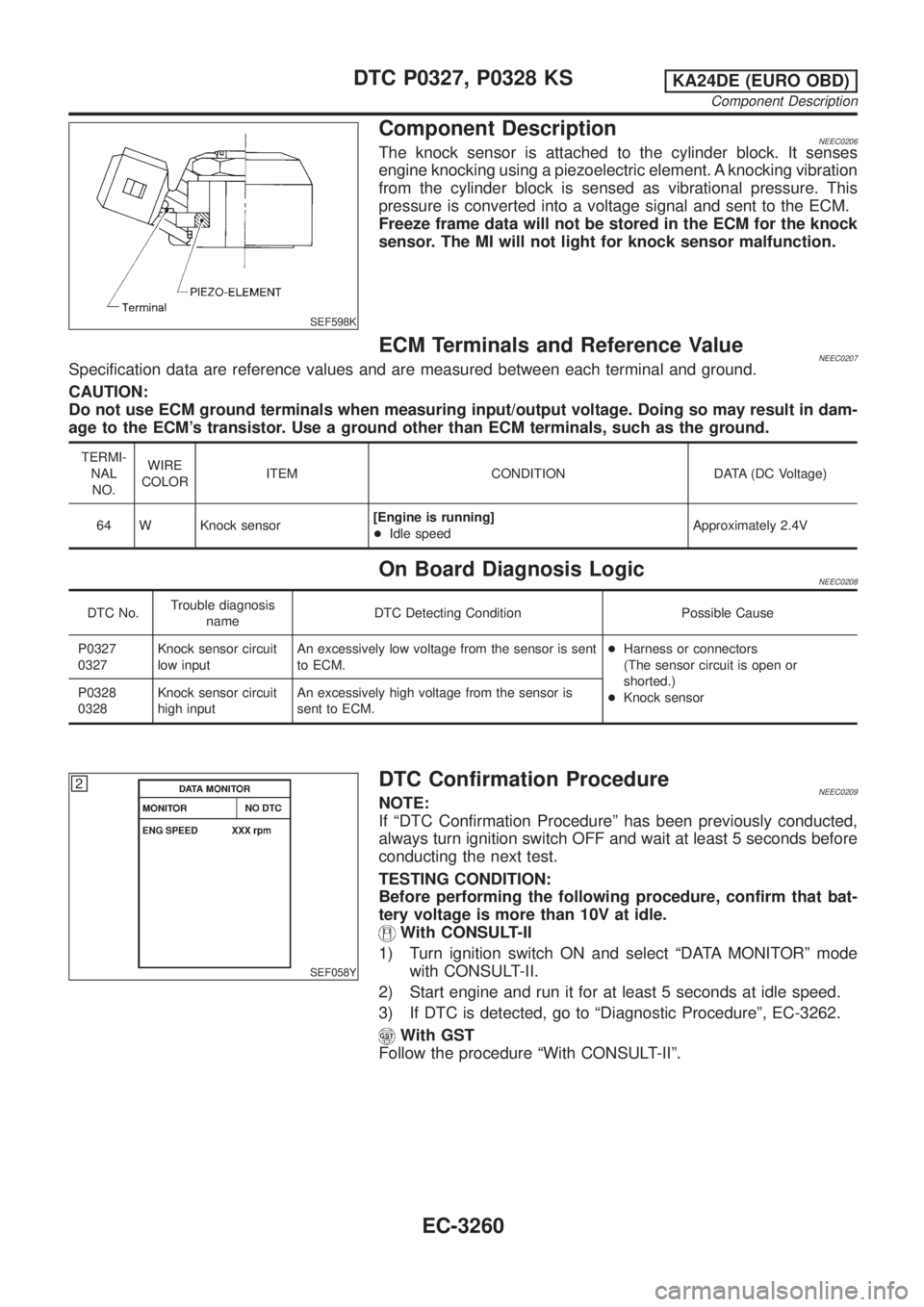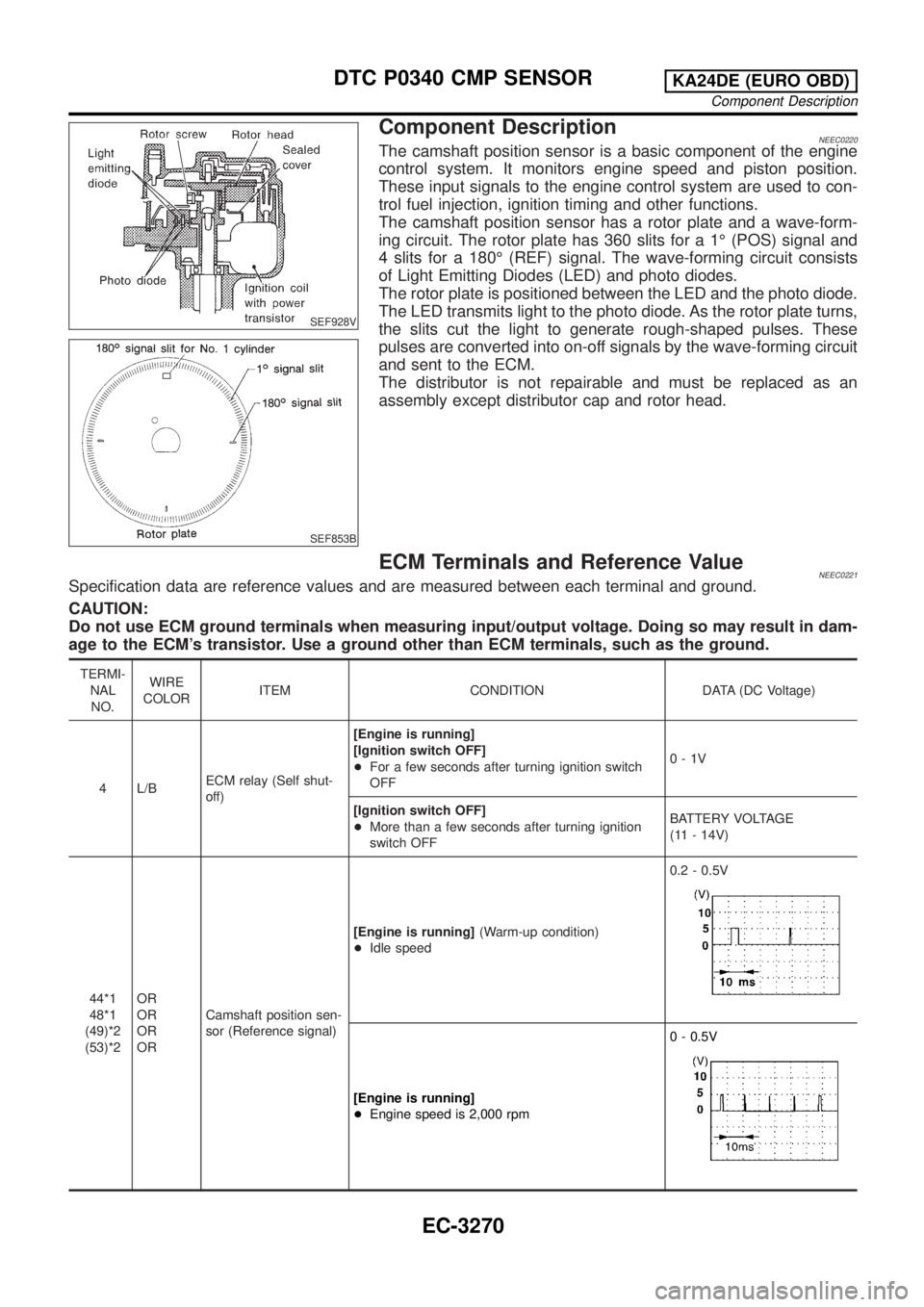2001 NISSAN PICK-UP turn signal
[x] Cancel search: turn signalPage 269 of 1306

On Board Diagnosis LogicNEEC0192With the Air/Fuel Mixture Ratio Self-Learning Control, the actual mixture ratio can be brought closely to the
theoretical mixture ratio based on the mixture ratio feedback signal from the heated oxygen sensor 1. The ECM
calculates the necessary compensation to correct the offset between the actual and the theoretical ratios.
In case the amount of the compensation value is extremely large (The actual mixture ratio is too rich.), the
ECM judges the condition as the fuel injection system malfunction and lights up the MI (2 trip detection logic).
Sensor Input Signal to ECMECM func-
tionActuator
Heated oxygen sensor 1Density of oxygen in exhaust gas
(Mixture ratio feedback signal)Fuel injec-
tion & mix-
ture ratio
controlInjectors
DTC No. Malfunction is detected when ... Check Items (Possible Cause)
P0172
0172+Fuel injection system does not operate properly.
+The amount of mixture ratio compensation is too large.
(The mixture ratio is too rich.)+Heated oxygen sensor 1
+Injectors
+Exhaust gas leaks
+Incorrect fuel pressure
+Mass air flow sensor
SEF215Z
SEF058Y
DTC Confirmation ProcedureNEEC0193NOTE:
If ªDTC Confirmation Procedureº has been previously conducted,
always turn ignition switch OFF and wait at least 5 seconds before
conducting the next test.
With CONSULT-II
1) Start engine and warm it up to normal operating temperature.
2) Turn ignition switch OFF and wait at least 5 seconds.
3) Turn ignition switch ON and select ªSELF-LEARNING CONTº
in ªWORK SUPPORTº mode with CONSULT-II.
4) Clear the self-learning control coefficient by touching ªCLEARº.
5) Select ªDATA MONITORº mode with CONSULT-II.
6) Start engine again and let it idle for at least 10 minutes.
The 1st trip DTC P0172 should be detected at this stage, if a
malfunction exists. If so, go to ªDiagnostic Procedureº,
EC-3247.
7) If it is difficult to start engine at step 6, the fuel injection sys-
tem has a malfunction.
8) Crank engine while depressing accelerator pedal. If engine
starts, go to ªDiagnostic Procedureº, EC-3247. If engine does
not start, remove ignition plugs and check for fouling, etc.
AEC131A
With GST
1) Start engine and warm it up to normal operating temperature.
2) Turn ignition switch OFF and wait at least 5 seconds.
3) Disconnect mass air flow sensor harness connector. Then
restart and run engine for at least 3 seconds at idle speed.
4) Stop engine and reconnect mass air flow sensor harness con-
nector.
5) Select ªMODE 7º with GST. Make sure 1st trip DTC P0102 is
detected.
6) Select ªMODE 4º with GST and erase the 1st trip DTC P0102.
DTC P0172 FUEL INJECTION SYSTEM
FUNCTION
KA24DE (EURO OBD)
On Board Diagnosis Logic
EC-3244
Page 276 of 1306

On Board Diagnosis LogicNEEC0202When a misfire occurs, engine speed will fluctuate. If the engine speed fluctuates enough to cause the CKP
sensor signal to vary, the ECM can determine that a misfire is occurring.
Sensor Input Signal to ECM ECM function
Crankshaft position sensor (OBD) Engine speed On board diagnosis of misfire
The misfire detection logic consists of the following two conditions.
1. One Trip Detection Logic (Three Way Catalyst Damage)
On the first trip that a misfire condition occurs that can damage the three way catalyst (TWC) due to
overheating, the MI will blink.
When a misfire condition occurs, the ECM monitors the CKP sensor signal every 200 engine revolutions
for a change.
When the misfire condition decreases to a level that will not damage the TWC, the MI will turn off.
If another misfire condition occurs that can damage the TWC on a second trip, the MI will blink.
When the misfire condition decreases to a level that will not damage the TWC, the MI will remain on.
If another misfire condition occurs that can damage the TWC, the MI will begin to blink again.
2. Two Trip Detection Logic (Exhaust quality deterioration)
For misfire conditions that will not damage the TWC (but will affect vehicle emissions), the MI will only light
when the misfire is detected on a second trip. During this condition, the ECM monitors the CKP sensor
signal every 1,000 engine revolutions.
A misfire malfunction can be detected on any one cylinder or on multiple cylinders.
DTC No. Malfunction is detected when ... Check Items (Possible Cause)
P0300
0300+Multiple cylinders misfire.+Improper spark plug
+Insufficient compression
+Incorrect fuel pressure
+The injector circuit is open or shorted
+Injectors
+Intake air leak
+The ignition secondary circuit is open or shorted
+Lack of fuel
+Drive plate/Flywheel
+Heated oxygen sensor 1
+Incorrect distributor rotor P0301
0301+No. 1 cylinder misfires.
P0302
0302+No. 2 cylinder misfires.
P0303
0303+No. 3 cylinder misfires.
P0304
0304+No. 4 cylinder misfires.
SEF174Y
DTC Confirmation ProcedureNEEC0203CAUTION:
Always drive vehicle at a safe speed.
NOTE:
If ªDTC Confirmation Procedureº has been previously conducted,
always turn ignition switch OFF and wait at least 5 seconds before
conducting the next test.
With CONSULT-II
1) Turn ignition switch ON, and select ªDATA MONITORº mode
with CONSULT-II.
2) Start engine and warm it up to normal operating temperature.
DTC P0300 - P0304 NO.4-1CYLINDER MISFIRE, MULTIPLE CYLINDER
MISFIRE
KA24DE (EURO OBD)
On Board Diagnosis Logic
EC-3251
Page 285 of 1306

SEF598K
Component DescriptionNEEC0206The knock sensor is attached to the cylinder block. It senses
engine knocking using a piezoelectric element. A knocking vibration
from the cylinder block is sensed as vibrational pressure. This
pressure is converted into a voltage signal and sent to the ECM.
Freeze frame data will not be stored in the ECM for the knock
sensor. The MI will not light for knock sensor malfunction.
ECM Terminals and Reference ValueNEEC0207Specification data are reference values and are measured between each terminal and ground.
CAUTION:
Do not use ECM ground terminals when measuring input/output voltage. Doing so may result in dam-
age to the ECM's transistor. Use a ground other than ECM terminals, such as the ground.
TERMI-
NAL
NO.WIRE
COLORITEM CONDITION DATA (DC Voltage)
64 W Knock sensor[Engine is running]
+Idle speedApproximately 2.4V
On Board Diagnosis LogicNEEC0208
DTC No.Trouble diagnosis
nameDTC Detecting Condition Possible Cause
P0327
0327Knock sensor circuit
low inputAn excessively low voltage from the sensor is sent
to ECM.+Harness or connectors
(The sensor circuit is open or
shorted.)
+Knock sensor P0328
0328Knock sensor circuit
high inputAn excessively high voltage from the sensor is
sent to ECM.
SEF058Y
DTC Confirmation ProcedureNEEC0209NOTE:
If ªDTC Confirmation Procedureº has been previously conducted,
always turn ignition switch OFF and wait at least 5 seconds before
conducting the next test.
TESTING CONDITION:
Before performing the following procedure, confirm that bat-
tery voltage is more than 10V at idle.
With CONSULT-II
1) Turn ignition switch ON and select ªDATA MONITORº mode
with CONSULT-II.
2) Start engine and run it for at least 5 seconds at idle speed.
3) If DTC is detected, go to ªDiagnostic Procedureº, EC-3262.
With GST
Follow the procedure ªWith CONSULT-IIº.
DTC P0327, P0328 KSKA24DE (EURO OBD)
Component Description
EC-3260
Page 287 of 1306

Diagnostic ProcedureNEEC0211
1 RETIGHTEN GROUND SCREWS
Loosen and retighten engine ground screws.
SEC309D
©GO TO 2.
2 CHECK INPUT SIGNAL CIRCUIT-1
1. Turn ignition switch OFF.
2. Disconnect ECM harness connector.
3. Check harness continuity between ECM terminal 64 and ground.
SEF173V
Resistance: Approximately 500 - 620 kW[at 25ÉC (77ÉF)]
It is necessary to use an ohmmeter which can measure more than 10 MW.
4. Also check harness for short to ground and short to power.
OK or NG
OK©GO TO 4.
NG©GO TO 3.
3 CHECK KNOCK SENSOR INPUT SIGNAL CIRCUIT FOR OPEN AND SHORT-II
1. Disconnect knock sensor harness connector.
2. Check harness continuity between ECM terminal 64 and knock sensor terminal 1. Refer to wiring diagram.
Continuity should exist.
3. Also check harness for short to ground and short to power.
OK or NG
OK©GO TO 4.
NG©Repair open circuit or short to ground or short to power in harness or connectors.
DTC P0327, P0328 KSKA24DE (EURO OBD)
Diagnostic Procedure
EC-3262
Page 292 of 1306

Diagnostic ProcedureNEEC0218
1 RETIGHTEN GROUND SCREWS
1. Turn ignition switch OFF.
2. Loosen and retighten engine ground screws.
SEC309D
©GO TO 2.
2 CHECK INPUT SIGNAL CIRCUIT
1. Disconnect crankshaft position sensor (OBD) and ECM harness connectors.
SEF335V
2. Check continuity between ECM terminal 47 and terminal 1. Refer to wiring diagram.
Continuity should exist.
3. Also check harness for short to ground and short to power.
OK or NG
OK©GO TO 4.
NG©GO TO 3.
3 DETECT MALFUNCTIONING PART
Check the following.
+Harness connectors E205, E33
+Harness connectors E101, M5
+Harness for open or short between crankshaft position sensor (OBD) and ECM
©Repair open circuit or short to ground or short to power in harness or connectors.
DTC P0335 CKP SENSOR (OBD)KA24DE (EURO OBD)
Diagnostic Procedure
EC-3267
Page 295 of 1306

SEF928V
SEF853B
Component DescriptionNEEC0220The camshaft position sensor is a basic component of the engine
control system. It monitors engine speed and piston position.
These input signals to the engine control system are used to con-
trol fuel injection, ignition timing and other functions.
The camshaft position sensor has a rotor plate and a wave-form-
ing circuit. The rotor plate has 360 slits for a 1É (POS) signal and
4 slits for a 180É (REF) signal. The wave-forming circuit consists
of Light Emitting Diodes (LED) and photo diodes.
The rotor plate is positioned between the LED and the photo diode.
The LED transmits light to the photo diode. As the rotor plate turns,
the slits cut the light to generate rough-shaped pulses. These
pulses are converted into on-off signals by the wave-forming circuit
and sent to the ECM.
The distributor is not repairable and must be replaced as an
assembly except distributor cap and rotor head.
ECM Terminals and Reference ValueNEEC0221Specification data are reference values and are measured between each terminal and ground.
CAUTION:
Do not use ECM ground terminals when measuring input/output voltage. Doing so may result in dam-
age to the ECM's transistor. Use a ground other than ECM terminals, such as the ground.
TERMI-
NAL
NO.WIRE
COLORITEM CONDITION DATA (DC Voltage)
4 L/BECM relay (Self shut-
off)[Engine is running]
[Ignition switch OFF]
+For a few seconds after turning ignition switch
OFF0-1V
[Ignition switch OFF]
+More than a few seconds after turning ignition
switch OFFBATTERY VOLTAGE
(11 - 14V)
44*1
48*1
(49)*2
(53)*2OR
OR
OR
ORCamshaft position sen-
sor (Reference signal)[Engine is running](Warm-up condition)
+Idle speed0.2 - 0.5V
[Engine is running]
+Engine speed is 2,000 rpm0 - 0.5V
DTC P0340 CMP SENSORKA24DE (EURO OBD)
Component Description
EC-3270
Page 296 of 1306
![NISSAN PICK-UP 2001 Repair Manual TERMI-
NAL
NO.WIRE
COLORITEM CONDITION DATA (DC Voltage)
(44)*2
49*1WCamshaft position sen-
sor (Position signal)[Engine is running]
+Warm-up condition
+Idle speedApproximately 2.5V
[Engine is running NISSAN PICK-UP 2001 Repair Manual TERMI-
NAL
NO.WIRE
COLORITEM CONDITION DATA (DC Voltage)
(44)*2
49*1WCamshaft position sen-
sor (Position signal)[Engine is running]
+Warm-up condition
+Idle speedApproximately 2.5V
[Engine is running](/manual-img/5/57372/w960_57372-295.png)
TERMI-
NAL
NO.WIRE
COLORITEM CONDITION DATA (DC Voltage)
(44)*2
49*1WCamshaft position sen-
sor (Position signal)[Engine is running]
+Warm-up condition
+Idle speedApproximately 2.5V
[Engine is running]
+Engine speed is 2,000 rpmApproximately 1.0V
67 W
Power supply for ECM[Ignition switch ON]BATTERY VOLTAGE
(11 - 14V)
72 W
117 W Current return[Engine is running]
+Idle speedBATTERY VOLTAGE
(11 - 14V)
*1: Model without NATS (Nissan Anti-Theft System)
*2: Model with NATS (Nissan Anti-Theft System)
On Board Diagnosis LogicNEEC0222
DTC No. Malfunction is detected when ... Check Items (Possible Cause)
P0340
0340A) Either 1É or 180É signal is not sent to ECM for the
first few seconds during engine cranking.+Harness or connectors
(The camshaft position sensor circuit is open or
shorted.)
+Camshaft position sensor
+Starter motor (Refer to SC section.)
+Starting system circuit (Refer to SC section.)
+Dead (Weak) battery B) Either 1É or 180É signal is not sent to ECM often
enough while the engine speed is higher than the
specified engine speed.
C) The relation between 1É and 180É signal is not in
the normal range during the specified engine
speed.
DTC P0340 CMP SENSORKA24DE (EURO OBD)
ECM Terminals and Reference Value
EC-3271
Page 300 of 1306

3 CHECK POWER SUPPLY
1. Disconnect camshaft position sensor harness connector.
SEC276D
2. Turn ignition switch ON.
3. Check voltage between terminal 5 and ground with CONSULT-II or tester.
SEF040S
Voltage: Battery voltage
OK or NG
OK©GO TO 5.
NG©GO TO 4.
4 DETECT MALFUNCTIONING PART
Check the following.
+Harness connectors E101, M5
+Harness for open or short between camshaft position sensor and ECM relay
+Harness for open or short between camshaft position sensor and ECM
©Repair open circuit or short to ground or short to power in harness or connectors.
5 CHECK INPUT SIGNAL CIRCUIT
1. Turn ignition switch OFF.
2. Disconnect ECM harness connector.
3. Check harness continuity between sensor terminal 4 and ECM terminal 49 or (44)*, sensor terminal 3 and ECM termi-
nals 44, 48 or (49, 53)*. Refer to wiring diagram.
Continuity should exist.
*: Model with NATS (Nissan Anti-Theft System)
4. Also check harness for short to ground and short to power.
OK or NG
OK©GO TO 6.
NG©Repair open circuit or short to ground or short to power in harness or connectors.
DTC P0340 CMP SENSORKA24DE (EURO OBD)
Diagnostic Procedure
EC-3275